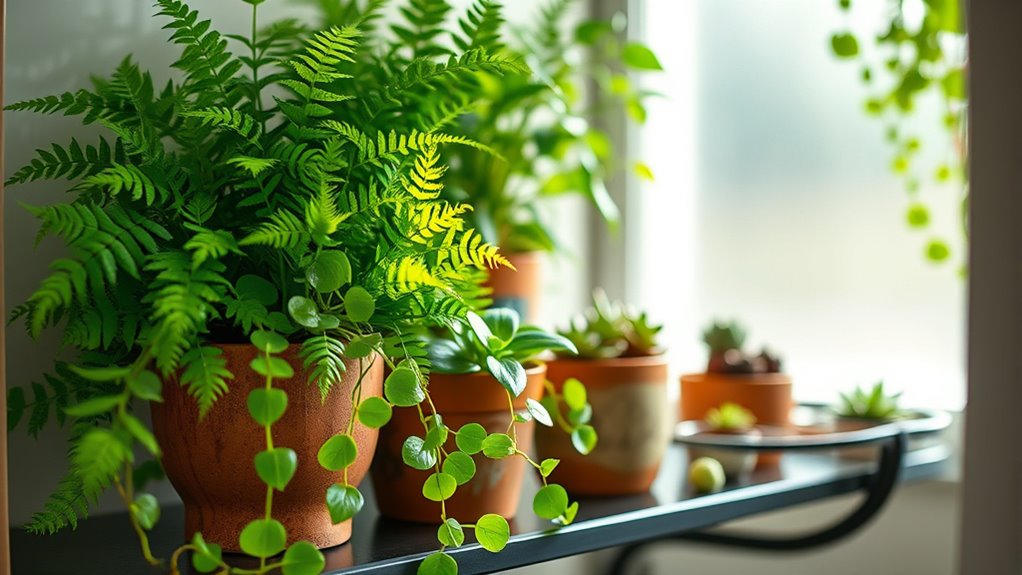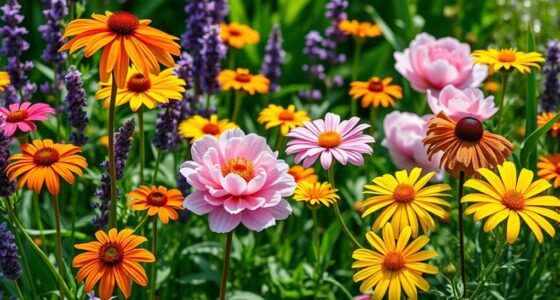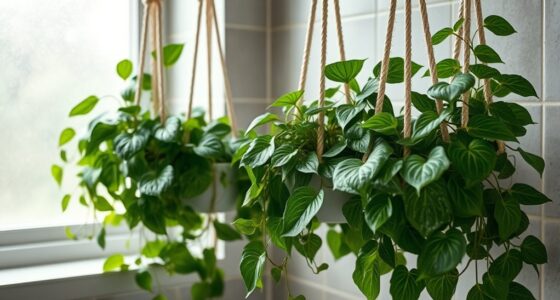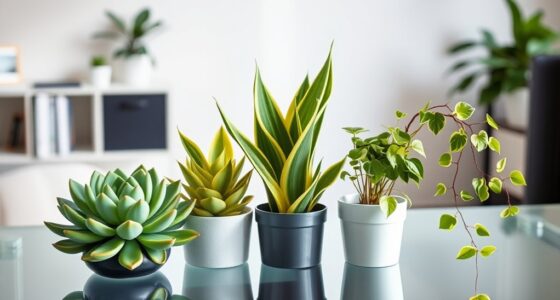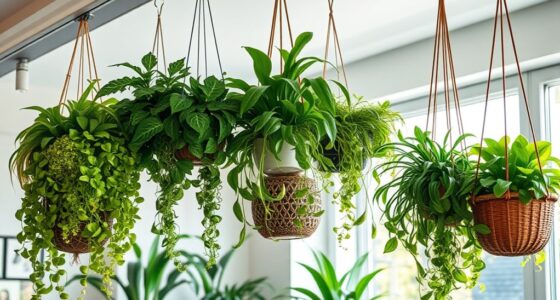To create vibrant, humidity-loving miniature plant decor in your small bathroom, choose plants like Pothos, Boston Fern, Peace Lilies, or Spider Plants that thrive in low light and high humidity. Place them near windows or use hanging planters to save space, and use decorative containers that match your style. Keep their soil moist but well-drained, monitor humidity levels, and regularly care for them. Want to turn your bathroom into a lush oasis? Explore tips on the best plants and display ideas below.
Key Takeaways
- Select small, humidity-loving plants like Boston Fern, Pothos, or Peace Lilies for optimal bathroom decor.
- Ensure proper drainage and consistent moisture without overwatering to keep plants healthy.
- Use vertical and space-saving display methods such as wall-mounted planters or hanging baskets.
- Place plants near indirect light sources and monitor humidity levels with hygrometers.
- Maintain regular care routines, including misting, pruning, and pest inspection, for thriving bathroom greenery.
Top 10 Miniature Plants for Moist Bathroom Environments
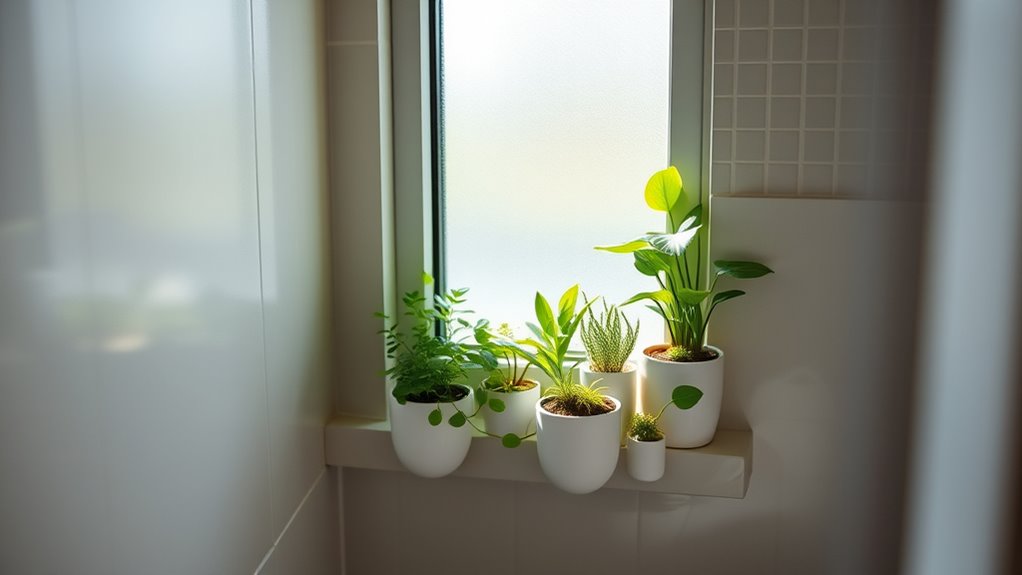
Moist bathroom environments provide the perfect conditions for many small plants to thrive, making them ideal choices for bathroom decor. When selecting plants, consider options that excel at air purification to improve your space’s air quality. Pet-friendly plants are also a smart choice, ensuring your furry friends stay safe while enjoying the greenery. Miniature varieties like the Parlor Palm, Boston Fern, and Peperomia are excellent for small spaces, thriving in humidity and low light. These plants not only enhance your bathroom’s aesthetic but also help filter toxins from the air, creating a healthier environment. With the right selection, your bathroom can become a lush, calming oasis that benefits both your health and your pets. Additionally, choosing plants with natural antioxidant properties can further improve indoor air quality and promote wellness. Proper humidity levels are vital for maintaining healthy, vibrant plants and ensuring their longevity in your bathroom environment. Maintaining appropriate air circulation can also prevent mold growth and keep your plants healthy.
Best Care Tips for Humidity-Loving Small Plants
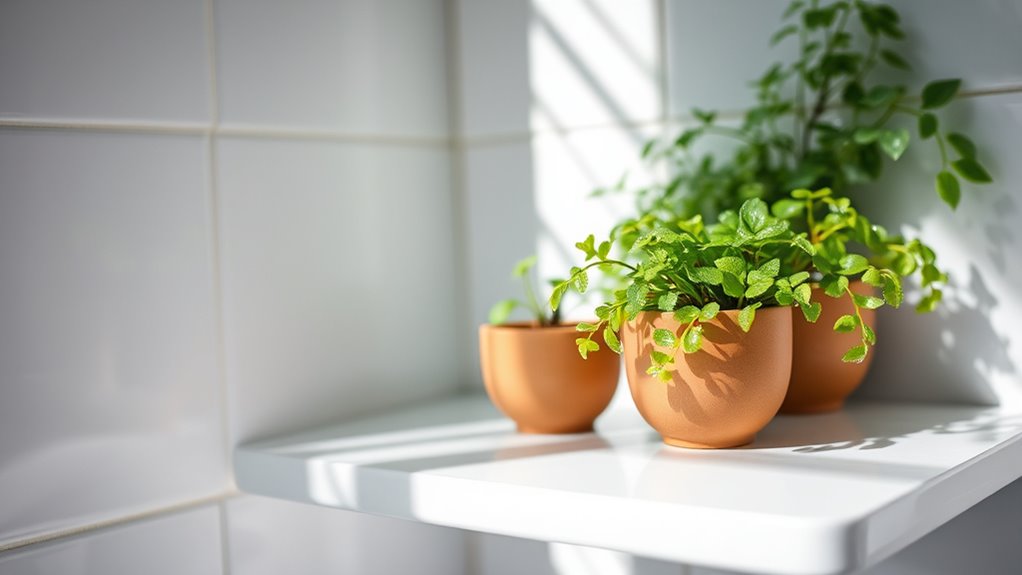
To keep your humidity-loving small plants healthy, you need to maintain consistent moisture without overwatering. Make sure your pots have proper drainage to prevent water from sitting at the roots, which can cause rot. Regularly monitor the humidity levels in your bathroom to guarantee they stay within the ideal range for your plants. Being aware of filter replacement indicators and relationship dynamics can help you better understand the importance of consistent care in nurturing your plants.
Maintain Consistent Moisture
Maintaining consistent moisture levels in your humidity-loving small plants is key to their health and vitality. To do this, pay attention to air circulation, which helps prevent excess humidity buildup that can lead to rot. Good airflow keeps moisture levels steady and reduces the risk of mold. Additionally, understand your plants’ light requirements, as proper lighting helps regulate their water uptake and evaporation. Avoid letting the soil dry out completely or stay overly wet; check moisture regularly by feeling the top inch of soil. Water when necessary, ensuring even dampness without overwatering. Ensuring proper airflow is essential for maintaining a stable environment, as it helps regulate humidity levels and prevents problems caused by excess moisture. Keeping a stable environment with adequate air circulation and suitable light helps your minis thrive with just the right moisture balance. Regularly assessing and adjusting your plant care routine aligns with maximizing space and organization principles, ensuring your small plants remain healthy and vibrant. Additionally, selecting plants that are naturally adapted to humidity levels can further improve their resilience and overall health.
Use Proper Drainage
Proper drainage is essential for humidity-loving small plants because it prevents water from pooling at the roots, which can cause rot. To achieve this, choose containers with effective drainage systems that allow excess water to escape easily. Avoid pots with flat bottoms or poor drainage designs that trap water, increasing the risk of root rot. Good drainage also helps manage water retention, ensuring the soil stays moist but not waterlogged. If your container lacks drainage holes, consider adding them or using a layer of gravel at the bottom to promote drainage. Regularly check that excess water drains away quickly after watering. Proper drainage keeps your humidity-loving minis healthy, preventing overwatering issues while maintaining the ideal moisture balance. Additionally, understanding plant root health can help you select the best containers and watering practices for your mini plants.
Monitor Humidity Levels
Since humidity is essential for small, moisture-loving plants, regularly monitoring the levels helps you keep conditions ideal. Use a hygrometer to check humidity in your bathroom, especially around your plant potting area. Adjustments can be made by increasing ventilation or misting plants if needed. Keep in mind that sunlight exposure affects moisture levels, so position your plants where they get consistent light without drying out the air. Incorporating air quality monitoring can also optimize humidity control for your plants. Regularly assessing environmental factors such as humidity, temperature, and light can improve your plant care routine. Here are some tips to monitor humidity effectively:
- Check hygrometer readings daily
- Adjust plant watering based on humidity levels
- Use a humidity tray or mist plants to boost moisture
- Observe plant potting conditions to prevent over- or under-watering
Choosing the Perfect Spots for Your Tiny Bathroom Greens
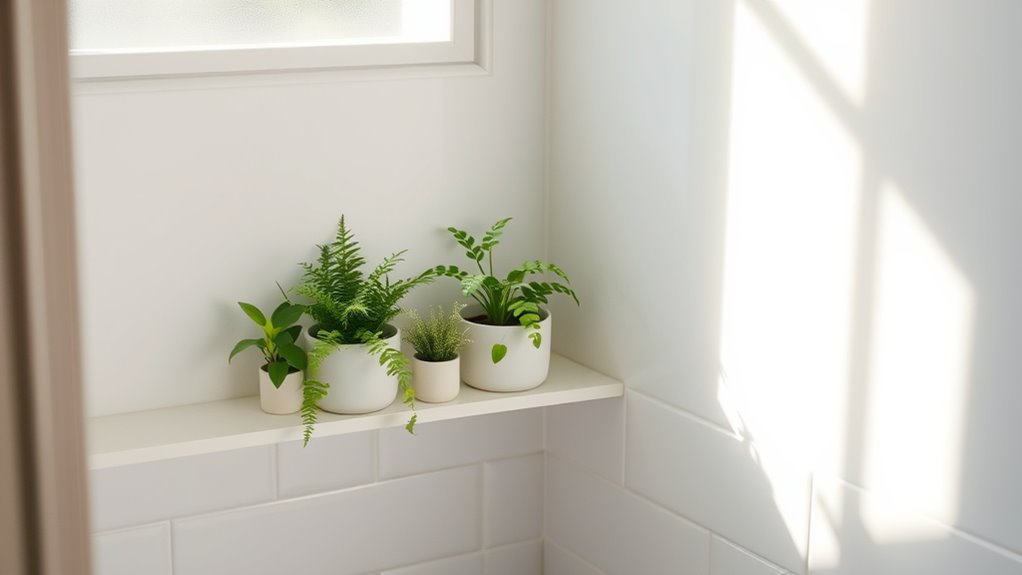
Finding the ideal spots for your tiny bathroom greens involves considering both light and space. Look for areas with good lighting conditions—near a window or a skylight works best—since most humidity-loving plants need indirect sunlight. Avoid placing them in completely dark corners, as they won’t thrive. Additionally, guarantee proper air circulation; stagnant air can lead to mold or pests. A spot that allows gentle airflow without drafts is preferable. Keep your plants away from direct heat sources like radiators or vents, which can dry out the air and harm your greens. By choosing spots with balanced light and good air circulation, you’ll create an environment where your tiny bathroom plants can flourish and stay healthy. Moreover, ensuring your plants are in automation-friendly environments can help maintain consistent humidity levels that are essential for their health. Proper humidity levels are crucial for these plants to thrive, so selecting spots that naturally support or can be easily adapted to such conditions will benefit your greenery. Using humidity monitors can further assist in maintaining the ideal environment for your plants.
Low-Maintenance Plants That Thrive in Small Spaces
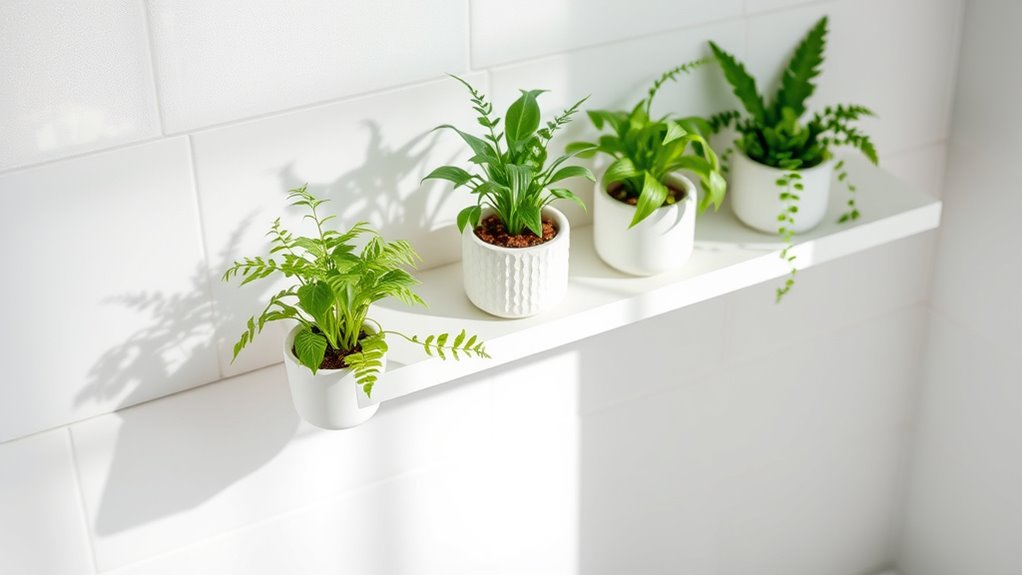
Opting for low-maintenance plants is a smart choice when decorating small bathrooms, especially if you want greenery that thrives with minimal effort. These plants often excel at air purification and can naturally help with pest control, making them ideal for limited spaces. Look for varieties that require little watering and tolerate humidity fluctuations. Consider:
Choose low-maintenance, air-purifying plants perfect for small bathrooms with minimal care.
- Snake Plant: Easy to care for, purifies air, resists pests
- ZZ Plant: Low light tolerance, minimal watering needs
- Pothos: Grows quickly, improves air quality
- Spider Plant: Pest-resistant, air-purifying benefits
These plants are perfect for small bathrooms, providing lush greenery without demanding much attention, and they contribute to a healthier environment.
Creative Ways to Display Miniature Bathroom Plants
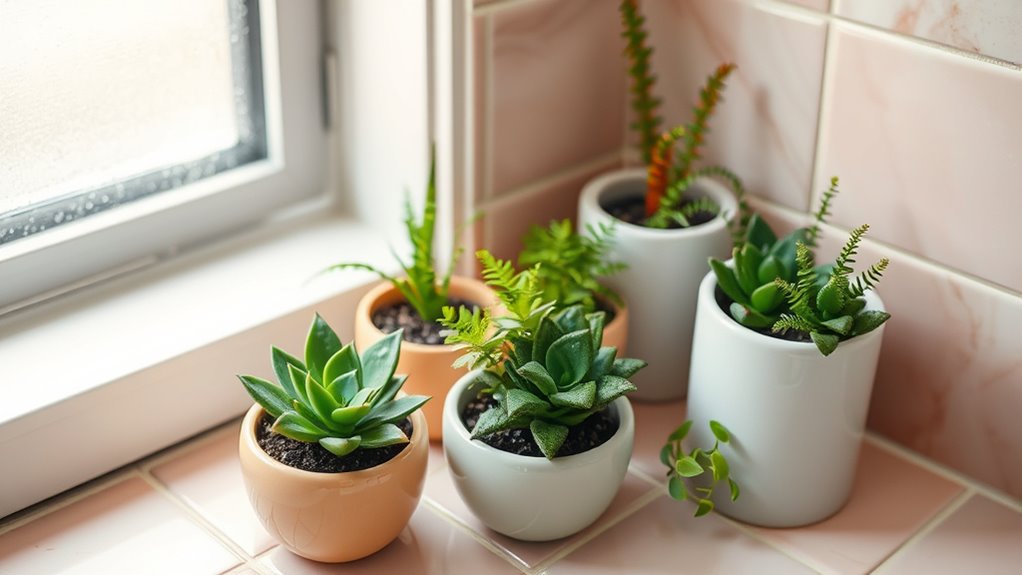
Creative display methods can transform miniature bathroom plants into eye-catching decor. You can elevate your garden aesthetics by experimenting with unique containers and arrangements. Use hanging planters, wall-mounted shelves, or vintage jars to add visual interest. Grouping plants in clusters creates a lush, mini garden vibe, while placing them near mirrors enhances natural light and makes the space feel larger. Regular plant grooming keeps your greenery tidy, ensuring they look their best. Consider contrasting textures or colors for a striking display. Here’s a quick guide to ideas:
| Display Method | Effect |
|---|---|
| Hanging planters | Adds vertical interest and saves space |
| Wall-mounted shelves | Creates a layered look for variety |
| Small terrariums | Showcases tiny ecosystems beautifully |
| Vintage containers | Enhances garden aesthetics with charm |
| Clustered pots | Creates a lush, mini garden feel |
Additionally, selecting humidity-loving plants suited for small bathroom environments will help your display thrive.
Combining Style and Function: Decorating With Small Greenery
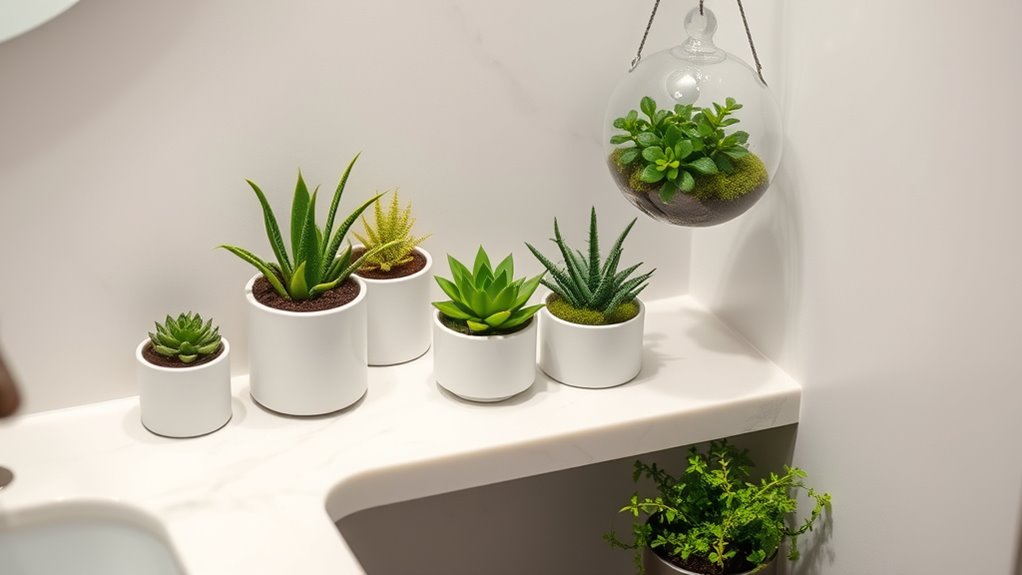
In small bathrooms, integrating greenery isn’t just about adding visual appeal—it’s about enhancing functionality as well. To do this effectively, focus on plant pruning to keep your greenery healthy and compact, ensuring it fits your space. Soil selection is vital; choose well-draining, moisture-retentive soil suitable for humidity-loving plants. You can also combine style and practicality by using decorative pots that complement your bathroom decor. Consider vertical arrangements to save space or placing plants on shelves for easy access and maintenance. Regularly prune to encourage growth and prevent overgrowth, and select soil that retains moisture without becoming soggy. Proper soil selection helps your mini plants thrive while maintaining a clean, cohesive look in your bathroom. Incorporating remote hackathons can also inspire innovative ideas for creative plant arrangements or smart gardening solutions in small spaces, especially when exploring plant care technology that optimizes growth conditions.
Common Mistakes to Avoid When Growing Mini Plants in Bathrooms
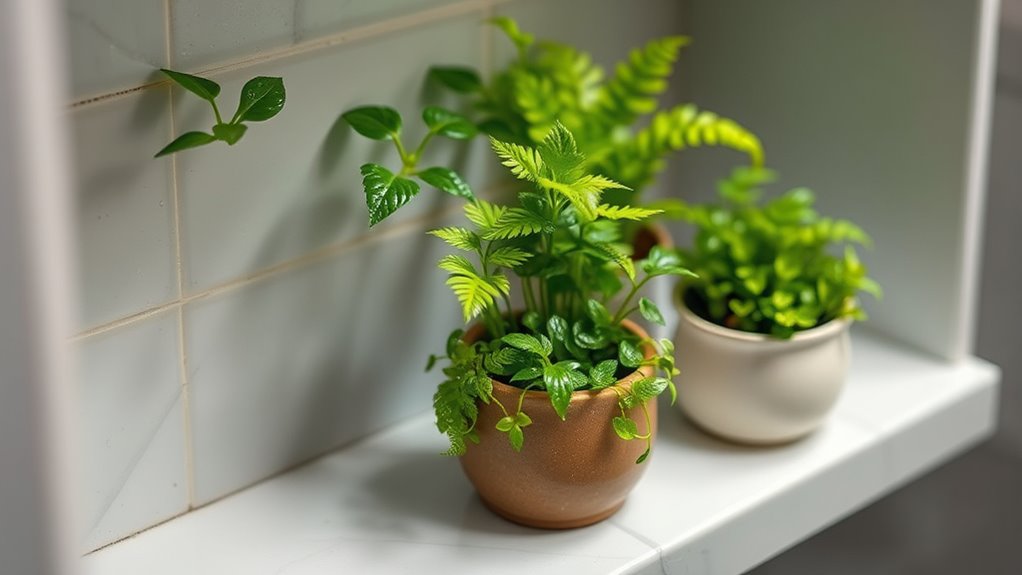
While incorporating small plants into your bathroom can boost its charm, there are common pitfalls that can hinder their growth and health. One mistake is neglecting lighting considerations; many mini plants need bright, indirect light, so placing them in dark corners can stunt their growth or cause yellowing. Another error is overwatering or underwatering—finding the right watering frequency is vital because bathroom humidity can be deceptive. Too much water can lead to root rot, while too little can cause dehydration. Additionally, ignoring ventilation can create excess moisture, fostering mold and pests. Regularly assess your plants’ needs, adjust light placement, and establish a consistent watering routine to keep your mini plants thriving. Properly managing self watering planters can also help maintain optimal moisture levels and prevent overwatering issues, ensuring your bathroom greenery flourishes.
How to Propagate and Repot Your Small Bathroom Plants

Propagating your small bathroom plants is a great way to grow your collection, and there are simple techniques like cuttings and division that work well. When repotting, choose containers that accommodate the plant’s root system and consider the humid environment of your bathroom. Follow these tips to keep your plants healthy and thriving in their new pots.
Propagation Techniques for Mini Plants
To successfully propagate your small bathroom plants, start by choosing healthy, mature specimens with strong roots or new growth. Proper propagation methods ensure healthy development and easier repotting later. Focus on maintaining soil aeration to prevent root rot, which is crucial in humid environments. When root pruning, carefully trim dead or crowded roots to encourage new growth. You can propagate plants through cuttings, division, or leaf propagation, depending on the species. Here’s how to approach it:
- Use clean, sharp tools for cuttings or division
- Keep soil well-draining and aerated during propagation
- Dip cuttings in rooting hormone to promote root development
- Regularly monitor moisture levels to prevent overwatering
Following these techniques will help you grow thriving mini plants perfect for your bathroom.
Repotting Tips for Humid Spaces
Properly repotting your small bathroom plants helps guarantee their continued health in humid environments. Start by choosing a slightly larger pot with drainage holes to improve soil aeration, preventing root rot. When repotting, gently loosen roots and remove excess old soil. Use fresh, well-draining potting mix suited for humidity-loving plants. To promote healthy growth, adjust your fertilizer schedule—apply a balanced, water-soluble fertilizer every few weeks, especially during active growing seasons. Avoid over-fertilizing, as excess nutrients can cause salt buildup in humid conditions. After repotting, place your plants in spots with indirect light and maintain consistent moisture levels. Regularly check for signs of stress or overwatering, and adjust your care routine accordingly. Proper repotting ensures your minis thrive in the moist, cozy bathroom environment.
Seasonal Care and Adjustments for Miniature Humidity Plants

As the seasons change, you’ll need to modify your miniature humidity plants to make certain they thrive year-round. In colder months, reduce watering frequency to prevent overwatering, focusing on seasonal watering needs. During warmer months, increase watering slightly to compensate for higher evaporation. Plant rotation is also important; move your plants to spots with different light or humidity levels to prevent stress. Keep an eye on humidity levels and adjust if your bathroom becomes drier or more humid. Additionally, consider relocating plants temporarily if they need more or less light. Regularly monitor for pests or signs of stress and make quick adjustments. These seasonal care tips help ensure your tiny greens stay healthy and vibrant through every season.
DIY Ideas for Enhancing Your Bathroom With Tiny Greenery
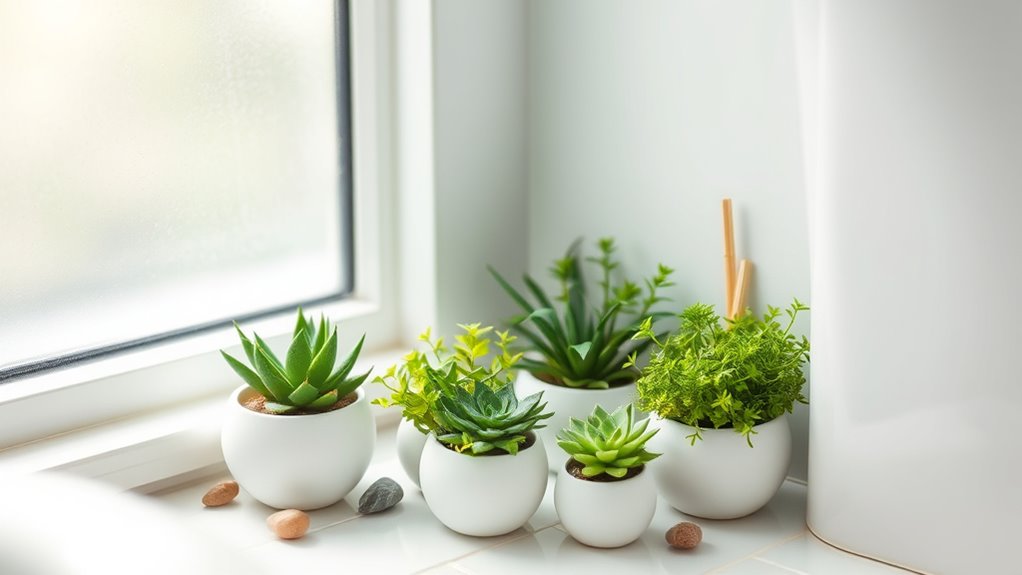
Looking to boost your bathroom’s vibe with tiny plants? You can choose humidity-loving varieties, get creative with display ideas, and keep your greenery thriving with simple maintenance tips. These DIY tricks will make your small space feel fresh and lively.
Ideal Humidity Plants
Since bathrooms tend to have higher humidity levels, they create an ideal environment for certain plants that thrive in moist conditions. These humidity-loving plants not only enhance your space’s aesthetic appeal but also contribute to air purification. When choosing ideal humidity plants, consider varieties that flourish in damp environments and require minimal maintenance. Some great options include:
- Boston Ferns
- Peace Lilies
- Spider Plants
- Pothos
These plants are perfect for small bathrooms, helping to improve air quality while adding lush greenery. Their ability to thrive in humid conditions makes them low-maintenance choices that enhance your bathroom’s ambiance. Incorporating these greenery options can turn your small bathroom into a calming, fresh oasis.
Creative Display Techniques
Adding greenery to your small bathroom doesn’t have to be complicated; creative display techniques can transform tiny plants into eye-catching decor. Use diverse plant pot styles—like sleek ceramic, vintage tins, or hanging baskets—to add texture and personality. Arrange your plants decoratively by grouping different sizes and types or creating vertical displays with wall-mounted planters. Consider stacking small pots on shelves or placing them on mirrored trays for added visual interest. Incorporate decorative plant arrangements by intertwining vines or grouping succulents in geometric containers. These ideas not only maximize space but also highlight your plants’ charm.
| Plant Pot Styles | Decorative Arrangements | Space Optimization |
|---|---|---|
| Ceramic | Vines & Trailing Plants | Wall-mounted |
| Vintage Tins | Succulent Clusters | Shelving |
| Hanging Baskets | Geometric Containers | Vertical Stacking |
Maintenance Tips for Minis
To keep your tiny bathroom plants thriving, regular maintenance is essential. Establish consistent watering schedules to prevent both overwatering and dehydration. Check moisture levels regularly and adjust watering frequency accordingly. To prevent pests, inspect your plants weekly and remove any visible pests or debris. Additionally, ensure good air circulation and keep leaves dry to minimize pest attraction.
Here are some DIY ideas to enhance your minis:
- Use a small spray bottle to mist plants, boosting humidity and cleaning leaves.
- Create a simple drainage system with pebbles to avoid waterlogging.
- Apply organic pest prevention methods like neem oil or insecticidal soap.
- Rotate plants periodically for even light exposure.
Maintaining proper watering and pest prevention routines will keep your minis healthy and vibrant in your bathroom sanctuary.
Frequently Asked Questions
Which Miniature Plants Are Safest for Homes With Pets or Children?
When choosing miniature plants for your home, especially if you have pets or children, you want to prioritize pet-safe plants and child-friendly greenery. Some safe options include spider plants, parlor palms, and African violets, which are non-toxic and easy to care for. Always verify the specific plant’s safety, and keep small plants out of reach to prevent accidental ingestion. This way, you enjoy beautiful, safe greenery without worries.
How Often Should I Water My Small Bathroom Humidity-Loving Plants?
They say, “A little water goes a long way.” For your humidity-loving plants, follow a consistent watering schedule—usually once a week—adjusting based on humidity levels in your bathroom. If the air feels damp, cut back; if it’s dry, give them a gentle soak. Keep the soil moist but not soggy, ensuring your plants thrive in their cozy, humid environment.
Can These Tiny Plants Survive in Low-Light Bathroom Conditions?
You might wonder if humidity-loving tiny plants can survive in low-light bathroom conditions. While many such plants prefer humidity tolerance, they often need bright, indirect light to thrive. However, some low light plant options like pothos or snake plants can handle dimmer spaces. To keep them healthy, make sure you provide adequate humidity and avoid overwatering. With proper care, these plants can survive and even flourish in low-light bathrooms.
Are There Specific Soil Types Best Suited for Miniature Bathroom Plants?
Ever wondered what soil works best for your tiny bathroom plants? You’ll want a mix that offers good soil drainage to prevent root rot, like a blend of peat moss, perlite, or orchid bark. Opt for pots made from breathable materials such as terracotta or clay to help moisture escape. This combination keeps your miniature plants healthy and happy, even in humid bathroom environments. Do you have the perfect soil mix yet?
How Do I Prevent Mold and Mildew Growth Around My Small Plants?
To prevent mold and mildew around your small plants, you should practice mold prevention techniques like ensuring proper air circulation and avoiding overwatering. Use mildew-resistant plant care by selecting plants that thrive in high humidity and removing any excess water from saucers. Regularly wipe down surfaces and trim dead leaves to reduce damp spots. This keeps your bathroom environment healthier and your plants thriving without mold or mildew issues.
Conclusion
With the right humidity-loving plants, your small bathroom can become a lush oasis. Think of it like nurturing a tiny ecosystem—each plant, like a small act of care, contributes to a healthier, more vibrant space. Embrace the idea that even the tiniest greens can have a big impact, proving that patience and attention turn simple decor into a living, breathing sanctuary. Sometimes, it’s the smallest details that create the most lasting beauty.
